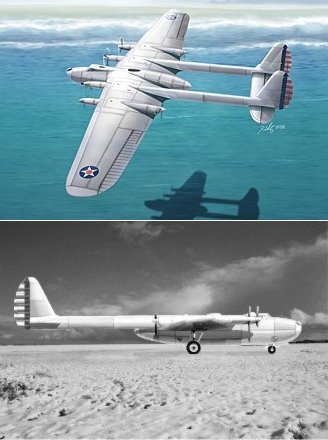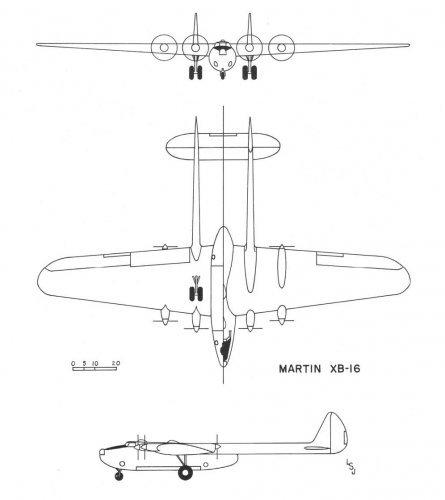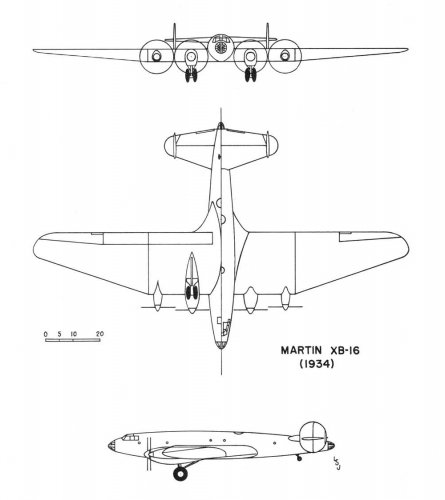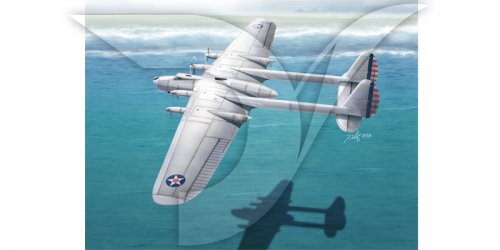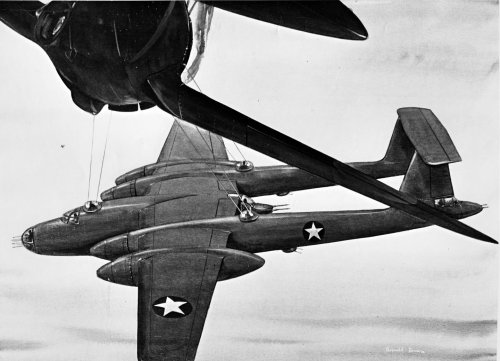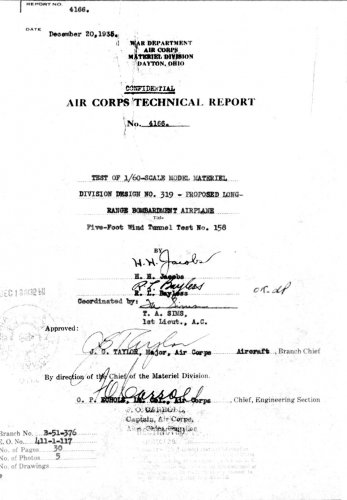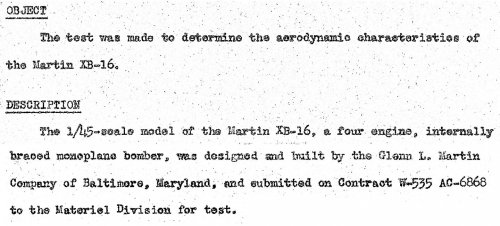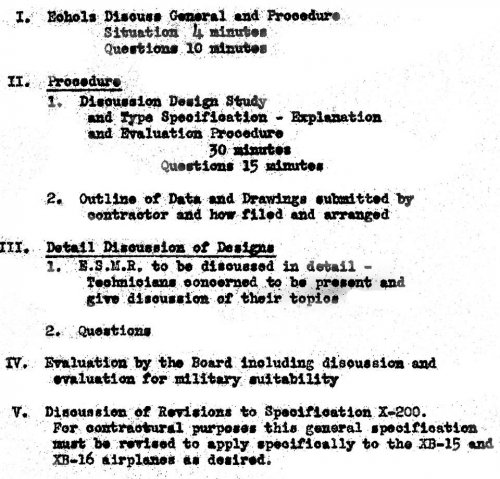- Joined
- 25 June 2009
- Messages
- 14,749
- Reaction score
- 6,111
This started off as an aside in the Douglas XB-19 thread, and was taking just too much importance, so I prefer to create a dedicated post to these designs. Why "these"? Because the Martin B-16 bomber project consisted of two very different designs, both studied under the Model 145 inhouse designation. According to hesham, the first design was Model 145A while the second one was 145B. I haven't been able to verify this, but it does make sense as it is not only coherent with Martin's designation system of the time, but also with the fact that the earlier design is described everywhere as Model 145A.
The first of these designs, the Model 145A, was entered in the same competition as the Boeing XBLR-1/XB-15, the Douglas XBLR-2/XB-19 and the Sikorsky XBLR-3 (the only known aircraft in the short-lived "BLR-for Bomber, Long Range" class). One source apparently suggested that the Martin 145A was to have been the XBLR-4 but there doesn't seem to be evidence to back this up for now. Its configuration was generally similar to its competitors, being a very large, four-engined long-range monoplane bomber. The only major difference in general design was the use of a twin fin instead of the single dorsal fin chosen by the other three competitors.
Here is what the Lloyd S. Jones's book U.S. Bombers (Aero, 1974) has to say about the Model 145A:
SaturnCanuck has exposed a very interesting theory that the B-15 and B-16 designations actually pre-dated the BLR-class, and that the B-15 merely retrieved its initial designation in the end. Two elements seem to validate this theory: (a) if the Martin 145A never got a BLR designation and it was in competition with the Boeing 294 and the BLR designators came first, then why not give it a BLR designation? and (b) if all four designs were entered at the same time and only later reassigned as B-types, why didn't the Douglas DS-167C get the B-17 designator? And if B-17 and B-18 had already been allocated by then, it can only mean that the B-15 and B-16 designations pre-date the BLR interlude.
Besides, Jones's book says the following about the Boeing design, which confirms the above:
Building on these sources and elements, we can elaborate the following chronology:
1°) Boeing and Martin are the first to propose a design and get the B-15 and B-16 designations in 1934.
2°) Someone comes up with the notion that this is a new category of bombers and should therefore belong to a separate list; the B-15 becomes the BLR-1.
3°) The Martin bomber gets the brush, so it doesn't get a BLR designation.
4°) In the meantime, Douglas and Sikorsky submit their own entries, and receive BLR-2 and BLR-3.
5°) Sikorsky's design is eliminated.
6°) Douglas wins over Boeing, but the Army Air Corps decides to get both designs built in prototype form and evaluate them.
7°) As it appears clearly that the bomber mission is evolving, the existence of a separate BLR class doesn't seem such a good idea after all; the BLR-1 returns to B-15 status; the BLR-2 receives the next available B-designation, namely B-19.
8°) Not being detered, Martin designers go back to the drawing board and come up in 1935 with the totally different Model 145B, a large twin-boom bomber with four tractor and two pusher engines. The Air Corps allocates the designation XB-16A (thus reusing the old B-16 slot used for the 1934 design).
Here is what U.S. Bombers has to say about the Model 145B:
Please note that Jones does not give a Martin designation for the second design, and that he calls both "XB-16" (which may be due to the fact that at the time of his book the subject had not been as researched as it has now).
Also, a comparison between the oft-circulated artist's view of the Model 145B and the actual model photographed at the time shows tremendous difference. It has been suggested that the painting may have emanated from the Air Force and not from Martin itself.
The first of these designs, the Model 145A, was entered in the same competition as the Boeing XBLR-1/XB-15, the Douglas XBLR-2/XB-19 and the Sikorsky XBLR-3 (the only known aircraft in the short-lived "BLR-for Bomber, Long Range" class). One source apparently suggested that the Martin 145A was to have been the XBLR-4 but there doesn't seem to be evidence to back this up for now. Its configuration was generally similar to its competitors, being a very large, four-engined long-range monoplane bomber. The only major difference in general design was the use of a twin fin instead of the single dorsal fin chosen by the other three competitors.
Here is what the Lloyd S. Jones's book U.S. Bombers (Aero, 1974) has to say about the Model 145A:
Late in 1934, the Martin Company laid down a proposal for a fast, long-range, heavy bomber, the Martin Model 145-A, and received the Air Corps designation XB-16. Though conforming to the new concept of large bombardment types and utilizing four engines, the XB-16 design deviated from the bulky, air-cooled radials now receiving wide acceptance. Four 1,000 hp Allison V-1710 liquid cooled engines were buried entirely in the wings driving 12 foot 3 inch propellers via extension shafts. The inboard nacelles were enlarged to accomodate the dual five foot tires of the landing gear. Estimated top speed, with supercharging, at 20,000 feet was 237 mph. Service ceiling was placed at 22,500 feet with a rate of climb of 740 feet per minute. A landing speed of 60 mph was anticipated by the use of the Fowler type flaps of 360 square feet which spanned 80 feet.
Defensive armament was to be carried in plexiglas nose and tail enclosures and retractable dorsal and ventral turrets. A bomb load of 12,180 pounds was to be transported 3,200 miles, and flight endurance with 4,238 gallons of fuel was 42 hours. A crew of ten was to have operated the aircraft.
© Aero Publishers 1974
SaturnCanuck has exposed a very interesting theory that the B-15 and B-16 designations actually pre-dated the BLR-class, and that the B-15 merely retrieved its initial designation in the end. Two elements seem to validate this theory: (a) if the Martin 145A never got a BLR designation and it was in competition with the Boeing 294 and the BLR designators came first, then why not give it a BLR designation? and (b) if all four designs were entered at the same time and only later reassigned as B-types, why didn't the Douglas DS-167C get the B-17 designator? And if B-17 and B-18 had already been allocated by then, it can only mean that the B-15 and B-16 designations pre-date the BLR interlude.
Besides, Jones's book says the following about the Boeing design, which confirms the above:
On June 1935, the proposal was given the designation XB-15 (...) For a short time during construction [the Boeing XB-15] was classed in a new group of experimental long range bombers as the XBLR-1.
© Aero Publishers 1974
Building on these sources and elements, we can elaborate the following chronology:
1°) Boeing and Martin are the first to propose a design and get the B-15 and B-16 designations in 1934.
2°) Someone comes up with the notion that this is a new category of bombers and should therefore belong to a separate list; the B-15 becomes the BLR-1.
3°) The Martin bomber gets the brush, so it doesn't get a BLR designation.
4°) In the meantime, Douglas and Sikorsky submit their own entries, and receive BLR-2 and BLR-3.
5°) Sikorsky's design is eliminated.
6°) Douglas wins over Boeing, but the Army Air Corps decides to get both designs built in prototype form and evaluate them.
7°) As it appears clearly that the bomber mission is evolving, the existence of a separate BLR class doesn't seem such a good idea after all; the BLR-1 returns to B-15 status; the BLR-2 receives the next available B-designation, namely B-19.
8°) Not being detered, Martin designers go back to the drawing board and come up in 1935 with the totally different Model 145B, a large twin-boom bomber with four tractor and two pusher engines. The Air Corps allocates the designation XB-16A (thus reusing the old B-16 slot used for the 1934 design).
Here is what U.S. Bombers has to say about the Model 145B:
Continued development of the original XB-16 design in 1935 led to a grotesque giant featuring a huge 4,256 square foot wing to which two thin tail booms were attached. An unusual podded, nacelle type fuselage housing the payload and crew of ten was suspended beneath the wing. Six buried Allison V-1710-3 engines were located in a unique four tractor, two pusher arrangement driving their propellers through extension shafts. Maximum speed anticipated was 256 mph, cruising at 140 mph, with a range of 3,300 miles. Bomb load was 2,500 pounds. Fuel tanks were to have a 7,435 gallon capacity.
It is interesting to note the first appearance of the tricycle type landing gear on this projected design. The large diameter main tires were partially exposed when the gear retracted into the wing. Estimated landing speed was 77 mph.
Wing span of this XB-16 configuration was to be 173 feet, the twin rudders extending to 114 feet 10 inches behind the nose. An empty weight of 50,660 pounds was determined with the gross being 104,880 pounds.
Although the engineering design was purchased by the A.A.F., no models of the Martin XB-16 were built and the project was cancelled.
© Aero Publishers 1974
Please note that Jones does not give a Martin designation for the second design, and that he calls both "XB-16" (which may be due to the fact that at the time of his book the subject had not been as researched as it has now).
Also, a comparison between the oft-circulated artist's view of the Model 145B and the actual model photographed at the time shows tremendous difference. It has been suggested that the painting may have emanated from the Air Force and not from Martin itself.


